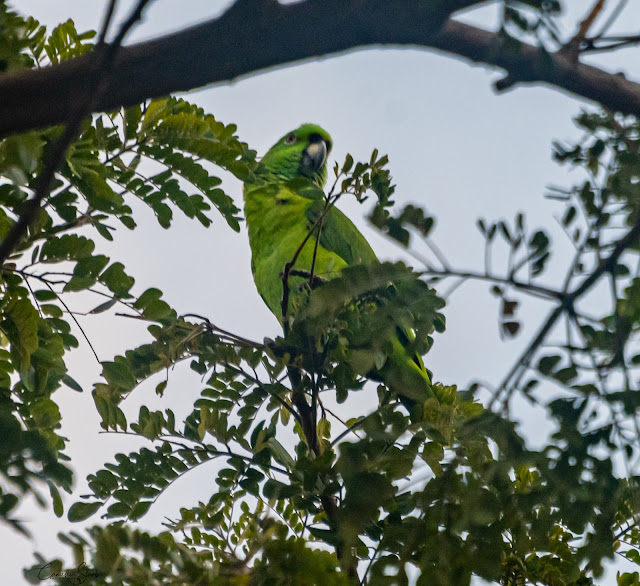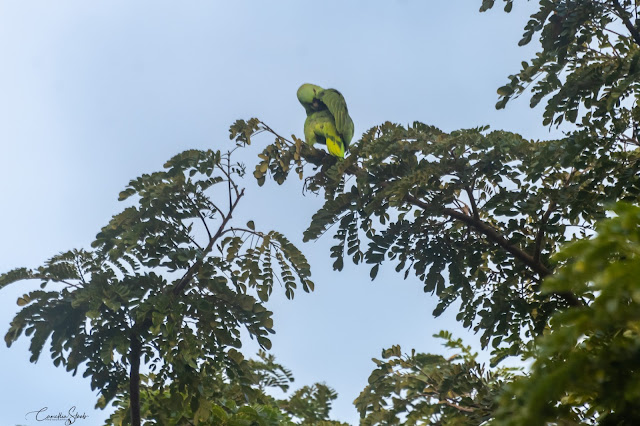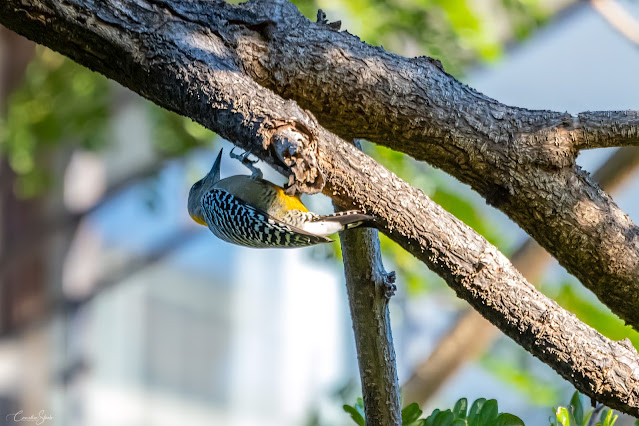A gentleman at the resort, seeing me bird watching, mentioned that there were a couple green parrots hanging around the trees in the early mornings. They usually came out around 5:30 in the morning, singing and making a racket until approximately 6:30- 7:00 a.m. and then they would disappear until the next day. He reminded me, several times during our conversation, that if I wanted to see them I would have to get up early. He must have thought I was one of those people that went on vacation and slept the day away.....little did he know!
I wasn't going to miss this opportunity of capturing a couple green parrots on camera, after all this was one of the reasons I brought a camera along.
One early morning, as expected, the parrots, which I later found out were called Yellow-naped parrots, were hanging on a couple of tree branches, somewhat hidden and making cooing sounds.
The best part.....there were two sets of parrots, each set facing each other on separate trees across from each other. Hence, the singing and cooing was loud and clear.
Trying to capture them was a tad more difficult than expected since they blended in with the leaves on the trees. But it was a great way to pass the early hours of the morning.
A few facts about the Yellow- Naped parrots:
- They are absolutely brilliant mimics.
- Are powerful flyers and can travel long distances.
- As fruit eaters, they perform a valuable role as seed dispersers.
- They are monogamous; once they reach maturity at two years old, they mate for life.
- Their nest cavities are located in tree holes as high as 30m above ground level.
- While the female parrot is incubating her eggs and tending the chicks, the male will bring back food but will not enter the nest hole.
- Breeding pairs are territorial, and tend to keep to their own areas.
Spotted this little beauty, Juvenile White Ibis, standing amongst the mangroves.
Climbed a watch tower and saw this Snowy Egret at a distance way beyond my reach.
Photo has been cropped to the max.
Have no clue who this guy is, but he falls into the bird category, hence he gets a spot. 😉
Hoffman's woodpecker is 18 cm (7.1 in) long and weighs 68 g (2.4 oz). Its upperparts and wings are neatly barred with black and white, and it has a white rump. The underparts are pale buff-grey with a yellow central belly patch. The male has a white forehead, red crown, and yellow nape. The female has a white crown and forehead and reduced yellow nape. Young birds are duller, have less white above and less yellow on the belly.This common and conspicuous species gives a rattling wicka-wicka-wicka call and both sexes drum on territory.
Walking the beach spotted the following birds. First one is a Whimbrel.
The Whimbrel is a large shorebird, it has stripes on the head, on this bird the most noticeable characteristic is the long decurved bill, which set it apart form other Costa Rica shorebirds except Long-billed Curlew, but they are easy to distinguish by the striped head on Whimbrel.
The Whimbrel can be found in mudflats, creeks edges, mangroves, beaches and rocky shores, where it moves actively looking for crabs, other crustaceans and insects by sticking its bill on small holes. At night they get together and form big groups to sleep, as well other migrant shorebirds join the group. More often seen alone, sometimes it can be seen with Willets.
The willet is an inelegant and heavily built shorebird with a structure similar to that of the common redshank but being larger in size than the greater yellowlegs while resembling a godwit in flight with black primary coverts and primaries contrasting with a broad white band, white secondaries with a white rump and gray tail band. With its reclassification into the Tringa genus, it stands as the largest species in this prominent sandpiper family. The black underwing coverts may be conspicuous in flight. Willets are identified on the ground by their gray legs and shortish, heavy but straight bill.
Obviously, there are many, many more colorful birds in the area which I was not privy to seeing, but I am glad to have spotted these few.







































Great bird captures - so much to see!
ReplyDelete